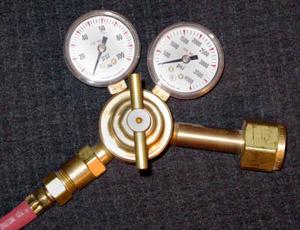CO2 Regulator
A regulator is a mechanical device that reduces the CO2
pressure from about 800 pounds per square inch (PSI) to a working
pressure that you set with the screw adjustment.
 Mine
is set to about 15 PSI. Mine
is set to about 15 PSI.I got this one at the local welding supplier--the
same place that I got the tank and the hosing. In fact, I bought the
whole setup at one time and the guy behind the counter attached the hose
and fittings for me while I waited.
It's a Victor Medalist SR5-60-320 from Victor Equipment Company in
Denton, TX. It cost $61.00 in 2001. I believe this model is made
specifically for CO2. It may be obsolete now. However, I suspect that
any regulator that your dealer recommends should work fine. Caution:
Getting liquid CO2 in these will damage them, so be sure to secure your CO2 tank in an upright position.
You're dealing with high pressure and an asphyxiating gas, so it pays to
be careful.
You should obtain and carefully follow the manufacturer's
instructions for your regulator. For reference, here's how I set up mine.
- I turn the pressure control lever (the vertical brass bar in the
photo) counter-clockwise until it's loose. This turns off the gas so
that nothing comes out in step 3.
- I screw the regulator onto the tank and then tighten it down
with a big crescent wrench. It's important to make sure that it's on
tightly so that it doesn't leak.
- I gradually turn the handle on the tank to admit gas into the
regulator.
-
I spray soapy water onto the joint and make sure there's no bubbling.
If there is, I tighten some more. If the joint still bubbles when the
nut is tight, there's a problem. Close the valve and consult your vendor.
Setting up the regulator
- Inspect the cylinder and regulator for damage.
- Secure the cylinder in the upright position.
- Crack the valve to clear out any dust or contaminants.
- Turn the adjusting screw (that's what they call it)
counterclockwise to release the pressure on the adjusting spring.
Turning on the cylinder valve
- Stand so the cylinder valve is between you and the regulator.
- Slowly and carefully open the cylinder valve until the maximum
pressure registers on the high pressure gauge. Now, open the valve
completely to seal the valve packing.
- Use a reverse flow check valve to prevent water from getting into the regulator, which will damage it.
|